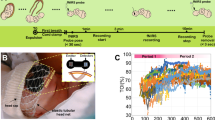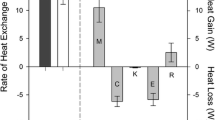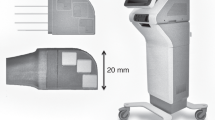Summary
Postterm and growth-retarded fetuses share a common problem which can be characterized by a discrepancy between the supply of oxygen and nutrients to, and the demand of the fetus. But, this “insufficient” placental exchange function may also extend to and affect its thermal homeostasis; e.g. when the capacity of convective (placenta) pathways is shifted towards conductive (surface) pathways for heat loss. Therefore, fetal scalp heat flux measurements, where heat serves as an intrinsic tracer for metabolic activity and placental exchange function, promised a new kind of information. In 81 pregnant women during labor we measured fetal scalp heat flux by means of an heat flux transducer attached to the fetal head and after the cervix had dilated to 3 cm. In the healthy fetuses we found a positive linear relationship between scalp heat flux and different anthropometric variables such as body length (r=0.432,n=65,P<0.01), head circumference and gestational age. In comparison, postmature and growth-retarded fetuses showed higher heat flux values than appropriately grown fetuses of the same length head size and gestational age. Moreover, in those fetuses scalp heat flux decreased by approximately 4 watt/m2 during the second stage and differed in this regard from the control group who showed stable values during labor and delivery. We conclude that scalp heat flux measurements may indicate disturbances of placental exchange before acute hypoxia occurs.
Similar content being viewed by others
References
Lin C-C, Evans MI (1984) Introduction. In: Lin C-C, Evans MI (eds) Intrauterine growth redardation. McGraw Hill, New York, p 10
Pritchard JA, MacDonald PC, Gant NF (1989) Inappropriate fetal growth. In: Williams Obstetrics, 18th edn (int'l). Applleton-Century Crofts, Norwalk Connecticut, p 764
Wigglesworth JS (1964) Experimental growth retardation in the foetal rat. J Pathol Bact 88:1
Gruenwald P (1963) Chronic fetal distress and placental insufficiency. Biol Neon 5:215
Adamsons K, Towell ME (1965) Thermal homeostasis in fetus and newborn. Anaesthesiology 20:531–545
Morishima OH, Yeh MN, Niemann WH, James LS (1977) Temperature gradient between fetus and mother as an index for assessing intrauterine fetal condition. Am J Obstet Gynecol 141:443–448
Rooth G, Huch A, Huch R, Peltonen R (1977) Fetal-maternal differences during labor. Contr Gynec Obstet 3:54–62
Zilianti M, Cabello F, Chacon NR, Rinicon CS, Salazar JR (1983) Fetal scalp temperature during labor and its relation to acid-base balance and condition of the newborn. Obstet Gynecol 61:474
Rudelstorfer R, Simbruner G, Bernaschek G, Rogan A, Szalay St, Janisch H (1983) Heat flux from the fetus during delivery and fetal outcome. Arch Gynecol 233:85
Rudelstorfer R, Simbruner G, Sharma V, Janisch H (1987) Scalp heat flux and its relationship to scalp blood pH of the fetus. Am J Obstet Gynecol 157:372
Van Eyck J, Wladimiroff JW, Noordam MJ et al. (1988) The blood flow velocimetry waveform in the fetal internal carotid and umbilical artery; its relation to fetal behavioural states in growth retarded fetus at 37–38 weeks gestation. Br J Obstet Gynaecol 95:473–477
Degani S, Paltiely L, Lewinsky R et al. (1989) Fetal internal carotid artery flow velocity time waveforms in twin pregnancies. Soc Perinat Obstet, Abstract No. 9
Simbruner G, Weninger M, Popow C, Hergoldt WJ (1985) Regional heat loss in newborn infants. Part II. Heat loss in newborns with various diseases — a method of assessing local metabolism and perfusion. S Afr Med J 68:948
Smith TM, Aarnouds JG (1984) Variability of fetal scalp blood flow during labour. Br J Obstet Gynaecol 91:524
Author information
Authors and Affiliations
Rights and permissions
About this article
Cite this article
Rudelstorfer, R., Simbruner, G. & Nanz, S. Scalp heat flux in postmature and in growth-retarded fetuses. Arch Gynecol Obstet 249, 19–25 (1991). https://doi.org/10.1007/BF02390703
Received:
Accepted:
Issue Date:
DOI: https://doi.org/10.1007/BF02390703




